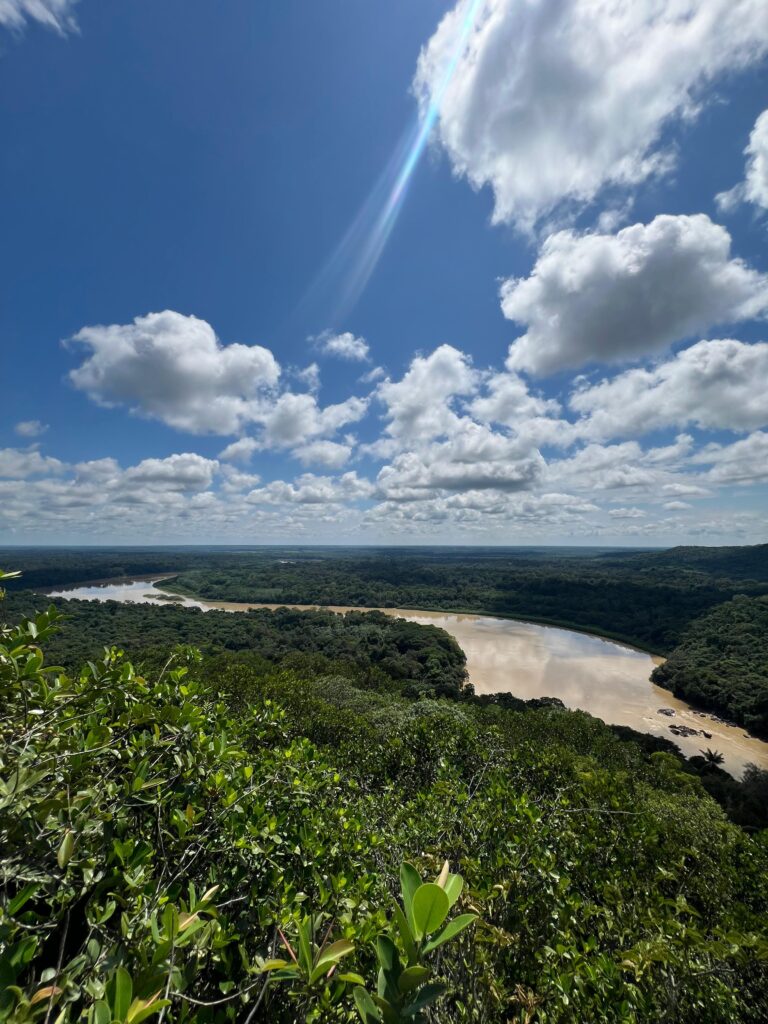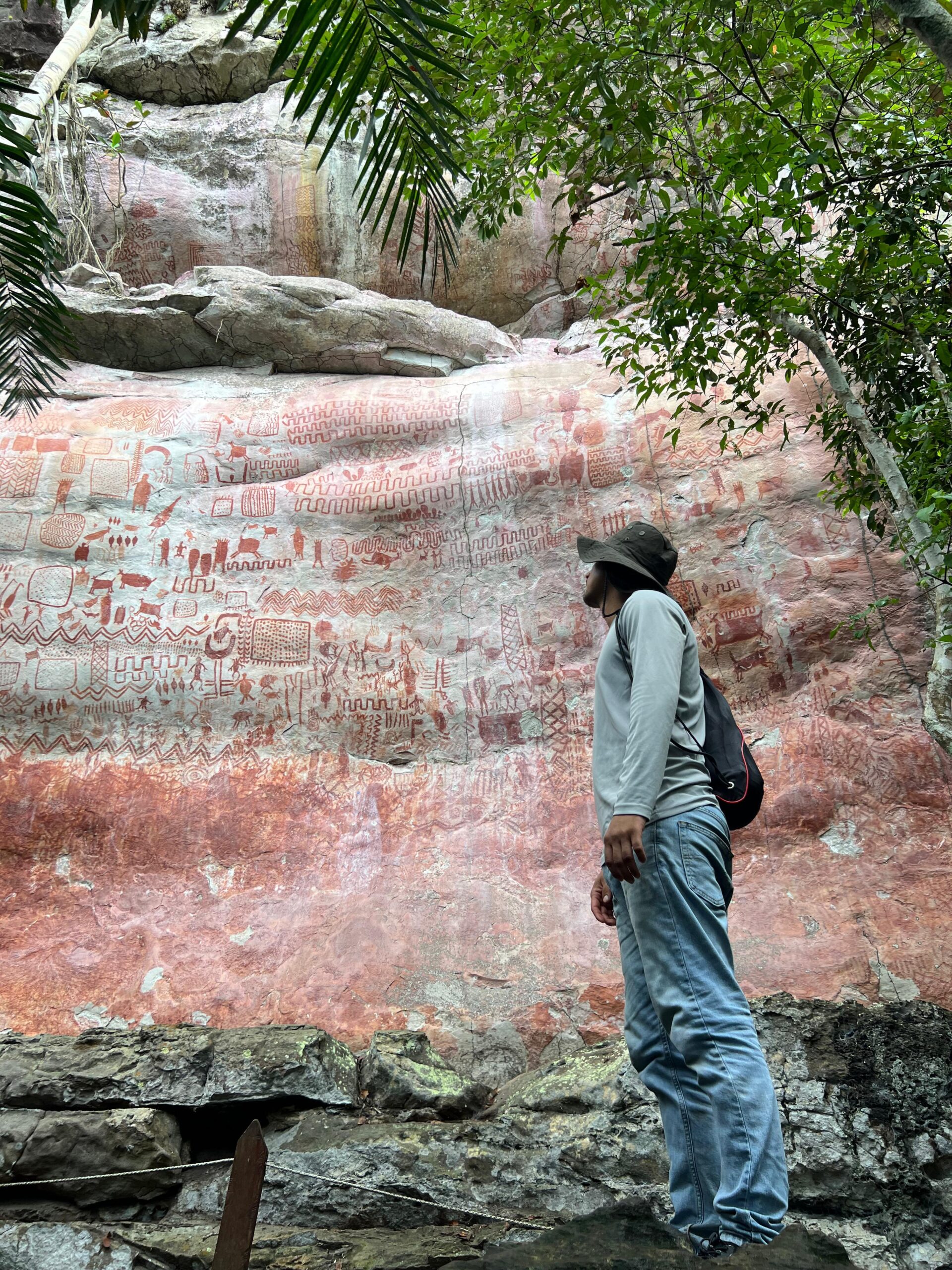
Guaviare is a department in Colombia rich in diversity. It’s a hidden gem that many people don’t know about, but still, many international tourists have visited this land for its rock paintings, which are over 5000 years old. The department of Guaviare is made up of four municipalities: San José del Guaviare, El Retorno, Calamar, and Miraflores. Its most important river is the Guaviare, formed by the confluence of the Guayabero and Ariari rivers. You’ll be enchanted by its beautiful landscapes, rock paintings, flora, fauna, and biodiversity in its cuisine. In San José del Guaviare, the reality show “Naked and Afraid” has even been filmed.
I did the tour with Geotours del Guaviare, and I totally recommend them for their professionalism and accommodations. They take care of transportation, tours, and meals, and they have extensive knowledge of the area’s history, animals, plants, and fauna. With over 15 years of experience in this region, they have a large number of guides who are at the service of travelers to ensure a memorable experience. If you like being in nature and enjoy hiking, I highly recommend them. The trails take no more than 2 hours and are not difficult to reach the tourist sites.
It’s important to bring the following items for this trip:
- Sunscreen
- Hat
- Hiking clothes
- Swimsuit
- Hiking shoes
- Insect repellent
- Raincoat
- Flashlight
- Water bottle
- Enthusiasm to explore
I chose the ‘SOS Guaviare’ plan, which includes 5 days and 4 nights, and is divided as follows:
Rocky Route

The hike is approximately 3 km long. We were taken in a 4×4 vehicle for about 1 hour and 30 minutes to the starting point of the hike. On this route, you’ll walk through streets, paths, crossways, tunnels, and other whimsical shapes of sedimentary rock with a high degree of erosion, resting on the Guiana Shield. The Ciudad de Piedra (Stone City) is a place with large rocks of various shapes that spark your imagination. Some of these rocks still have rock paintings, although they are gradually disappearing due to exposure to the elements, which accelerates their deterioration. In the natural tunnels, there are small caves where bats may live; it’s also said that felines like jaguars used to inhabit them in earlier years. It’s believed that these tunnels were once covered by the river, which explains the strong currents in the depth of the Guayabero River. Additionally, you can see the emblematic Guaviare flower along the route.
- Mirador de los Vientos (Wind’s Viewpoint)
- Ciudad de Piedra (Stone City)
- Flor del Guaviare (Guaviare Flower)
- Afloramiento Ancestral (Ancestral Outcropping)
- Túneles Naturales (Natural Tunnels)
Raudal Route

We were taken by car to the spot where we boarded a boat for the Raudal route, which includes a hike of approximately 4 km. You’ll navigate the second narrowest part of the Guayabero River, known as Angosturas II, between gigantic walls of sedimentary rock petrified by minerals derived from hydrocarbons that shimmer in the sunlight. Along the way, you’ll see many birds around the river. It’s a gigantic river, the largest I’ve seen so far, and it’s said to be over 50 meters deep. The boat ride takes less than 30 minutes before we began our hike to see the Raudal rock paintings. The hike is 4 km, including a viewpoint with a magnificent view of the Guayabero River, which divides the mountain ranges. After the tour, we were taken by boat to take a refreshing dip in the Piscina del Amor (Love Pool), perfect after the hike, and then we returned to the Raudal community where our lunch was waiting for us.
- Comunidad Raudal (Raudal Community)
- Río Guayabero, Raudal II (Guayabero River, Raudal II)
- Pictogramas del Raudal II (Raudal II Rock Paintings)
- Piscina del Amor (Love Pool)
- Mirador del Raudal II (Raudal II Viewpoint)
Rock Art Route

This is a hike of approximately 4 km. The rock paintings at Cerro Azul are where you’ll find the most indigenous rock paintings (over 10,000 years old), which will transport you to another dimension as you try to interpret and decipher the hidden secrets in these unique rock murals. The hike takes about 30 minutes to an hour. We also entered a cave where it’s said the shaman resides, and it’s completely dark inside. There’s also a beautiful viewpoint where you can see the plains of Guaviare. Later, we stopped at a farm for lunch, and the lady of the house was selling exotic fruits from the area, which I highly recommend trying. The Finca El Chontaduro is a house built by the man of the family, and it’s very unique. The owner worked in one of the coca camps in Colombia and explains the processes the coca leaf goes through to become the final product. This is an educational demonstration to discourage people from using this type of drug.
- Finca El Chontaduro (El Chontaduro Farm)
- Cerro Pinturas (Paintings Hill)
- Pictogramas Cerro Azul (Cerro Azul Rock Paintings)
- Caverna Cerro Pinturas (Paintings Hill Cave)
- Mirador Cerro Pinturas (Paintings Hill Viewpoint)
Orion Route

This is a hike of approximately 4 km that borders and enters the rupicolous forest of the Serranía de La Lindosa. You’ll be amazed by the huge natural arches and bridges, formed by sedimentary rocks eroded over time. The trail to see the Puerta de Orión (Orion’s Gate) is excellent, as you can see various birds in their natural habitat. It’s called Orion’s Gate because the Orion galaxy aligns with the hole or gate formed by the rocks. Additionally, the two rocks on either side are said to be guardians because they have a shape. The tour guide mentioned that tours are also organized in December to see the galaxy from there and camp.
- La Nevera (The Fridge)
- Puerta de Orión (Orion’s Gate)
- Mirador de Orión (Orion’s Viewpoint)
- Pozo Picapiedra (Picapiedra Well)
- Puentes Naturales (Natural Bridges)
They also offer the Nare route, but during my visit, it was unavailable because they were checking on the pink dolphins, known as “toninas,” which are native to the Amazon. The Laguna Damas del Nare is a magical place surrounded by Amazonian nature where you can not only enjoy dolphin watching at any time of the day but also swim with them in their natural environment.
You can also see the algae at Caño Cristales, which change color to red from August to October when they reach their peak intensity.

